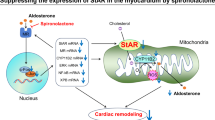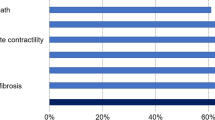Abstract
Aldosterone antagonists have been reported to prevent ventricular remodeling after myocardial infarction (MI) via their action to extracellular matrix (ECM). However, it remains largely unknown whether aldosterone antagonists attenuate myocyte loss in the remodeling process. The present study examined whether spironolactone prevents myocyte apoptosis and improves post-infarct ventricular remodeling in rats. MI was achieved by permanent occlusion of the left coronary artery. Administration of spironolactone (100 mg/kg/day) was started immediately after MI. Sprague-Dawley rats were divided into four groups: 1) sham, 2) spironolactone-treated sham, 3) untreated MI, 4) spironolactone-treated MI. Echocardiographic parameters (left ventricular [LV] diastolic dimension [LVDd], fractional shortening [%FS]), hemodynamic parameters (LV systolic pressure [LVSP], LV end-diastolic pressure [LVEDP], dP/dtmax and dP/dtmin) and collagen accumulation quantitated by Masson's Trichrome staining were significantly improved in the spironolactone-treated MI group on the 14th day, compared with the untreated MI group. Moreover, the percentage of apoptotic myocytes evaluated by terminal deoxynucleotide transferase–mediated dUTP nick end labeling (TUNEL) assay was significantly lower in the spironolactone-treated MI group on the 2nd (3.54% vs. 5.79% in untreated MI group), 7th (0.65% vs. 1.37% in untreated MI group) and 14th days (0.11% vs. 0.16% in untreated MI group). Real time reverse transcription–polymerase chain reaction (RT-PCR) analysis showed that the expression of mineralocorticoid receptor (MR) mRNA and that of 11β-hydroxysteroid dehydrogenase 2 (11β-HSD2) mRNA, which is known to confer aldosterone selectivity on MR, were upregulated in the untreated MI group, and that spironolactone significantly suppressed the expression of these genes. Moreover, spironolactone significantly inhibited aldosterone-induced apoptosis in cultured rat cardiac myocytes in a dose-dependent fashion. Our study demonstrates that, in addition to their effect on ECM, aldosterone antagonists inhibit myocyte apoptosis and prevent post-infarct ventricular remodeling by modulating the expression levels of MR and 11β-HSD2, which are enhanced in the remodeling heart.
Similar content being viewed by others
Article PDF
References
Pfeffer MA : Left ventricular remodeling after acute myocardial infarction. Annu Rev Med 1995; 46: 455–466.
Tatsumi T, Shiraishi J, Keira N, et al: Intracellular ATP is required for mitochondrial apoptotic pathways in isolated hypoxic rat cardiac myocytes. Cardiovasc Res 2003; 52: 428–440.
Fliss H, Gattinger D : Apoptosis in ischemic and reperfused rat myocardium. Circ Res 1996; 79: 949–956.
Kajstura J, Cheng W, Reiss K, et al: Apoptotic and necrotic myocyte cell deaths are independent contributing variables of infarct size in rats. Lab Invest 1996; 74: 86–107.
Cheng W, Kajstura J, Nitahara JA, et al: Programmed myocyte cell death affects the viable myocardium after infarction in rats. Exp Cell Res 1996; 226: 316–327.
Olivetti G, Quaini F, Sala R, et al: Acute myocardial infarction in humans is associated with the activation of programmed myocyte cell death in the surviving portion of the heart. J Mol Cell Cardiol 1996; 28: 2005–2016.
Beltrami CA, Finato N, Rocco M, et al: Structural basis of end-stage failure in ischemic cardiomyopathy in humans. Circulation 1994; 89: 151–163.
Olivetti G, Abbi R, Quaini F, et al: Apoptosis in the failing human heart. N Eng J Med 1997; 336: 1131–1141.
Saraste A, Pulkki K, Kallajoki M, et al: Cardiomyocyte apoptosis and progression of heart failure to transplantation. Eur J Clin Invest 1999; 29: 380–386.
Packer M : The neurohormonal hypothesis: a theory to explain the mechanism of disease progression in heart failure. J Am Coll Cardiol 1992; 20: 248–254.
Sato A, Saruta T : Aldosterone-induced organ damage: plasma aldosterone level and inappropriate salt status. Hypertens Res 2004; 27: 303–310.
Pitt B, Zannad F, Remme WJ, et al: The effect of spironolactone on morbidity and mortality in patients with severe heart failure. N Engl J Med 1999; 341: 709–717.
Pitt B, Remme W, Zannad F, et al, Eplerenone Post-Acute Myocardial Infarction Heart Failure Efficacy and Survival Study Investigators : Eplerenone, a selective aldosterone blocker, in patients with left ventricular dysfunction after myocardial infarction. N Engl J Med 2003; 348: 1309–1321.
Mizuno Y, Yoshimura M, Yasue H, et al: Aldosterone production is activated in the failing ventricles in human. Circulation 2001; 103: 72–77.
Yamamoto N, Yasue H, Mizuno Y, et al: Aldosterone is produced from ventricles in patients with essential hypertension. Hypertension 2002; 39: 958–962.
Silvestre JS, Robert V, Heymes C, et al: Myocardial production of aldosterone and corticosterone in the rat: physiological regulation. J Biol Chem 1998; 273: 4883–4891.
Struthers AD, MacDonald TM : Review of aldosterone-and angiotensin II–induced target organ damage and prevention. Cardiovasc Res 2004; 61: 663–670.
Funder JW : Glucocorticoid and mineralocorticoid receptors: biology and clinical relevance. Annu Rev Med 1997; 48: 231–240.
Slight SH, Ganjam VK, Gomez-Sanchez CE, Zhou MY, Weber KT : High affinity NAD+-dependent 11β-hydroxysteroid dehydrogenase in the human heart. J Mol Cell Cardiol 1996; 28: 781–787.
Mano A, Tatsumi T, Shiraishi J, et al: Aldosterone directly induces myocyte apoptosis through calcineurin-dependent pathways. Circulation 2004; 110: 317–323.
Kobara M, Tatsumi T, Kambayashi D, et al: Effect of ACE inhibition on myocardial apoptosis in an ischemia-reperfusion rat heart model. J Cardiovasc Pharmacol 2003; 41: 880–889.
Veliotes DGA, Woodiwiss AJ, Deftereos DAJ, Gray D, Osadchii O, Norton GR : Aldosterone receptor blockade prevents the transition to cardiac pump dysfunction induced by β-adrenoreceptor activation. Hypertension 2005; 45: 914–920.
Bäcklund T, Palojoki E, Saraste A, et al: Effect of vasopeptide inhibitor omapatrilat on cardiomyocyte apoptosis and ventricular remodeling in rat myocardial infarction. Cardiovasc Res 2003; 57: 727–737.
Delyani JA, Robinson EL, Rudolph AE : Effect of a selective aldosterone receptor antagonist in myocardial infarction. Am J Physiol 2001; 50: H647–H654.
Brilla CG, Pick R, Tan LB, Janicki JS, Weber KT : Remodeling of the rat right and left ventricles in experimental hypertension. Circ Res 1990; 67: 1355–1364.
Roussoulieres AL, Raisky O, Chalabreysse L, et al: Identification and characterization of two genes (MIP-1β, VE-CADHERIN) implicated in acute rejection in human heart transplantation: use of murine models in tandem with cDNA arrays. Circulation 2005; 111: 2636–2644.
Delcayre C, Swynghedauw B : Molecular mechanisms of myocardial remodeling. The role of aldosterone. J Mol Cell Cardiol 2002; 34: 1577–1584.
Solomon SD, Pfeffer MA : Aldosterone antagonism and myocardial infarction. From animals to man and back. J Am Coll Cardiol 2003; 42: 1674–1676.
Zannad F, Alla F, Dousset B, Perez A, Pitt B, RALES Investigators : Limitation of excessive extracellular matrix turnover may contribute to survival benefit of spironolactone therapy in patients with congestive heart failure: insights from the Randomized Aldactone Evaluation Study (RALES). Circulation 2000; 102: 2700–2706.
Suzuki G, Morita H, Mishima T, et al: Effects of long-term monotherapy with eplerenone, a novel aldosterone blocker, on progression of left ventricular dysfunction and remodeling in dogs with heart failure. Circulation 2002; 106: 2967–2972.
Fraccarollo D, Galuppo P, Hildemann S, Christ M, Ertl G, Bauersachs J : Additive improvement of left ventricular remodeling and neurohormonal activation by aldosterone receptor blockade with eplerenone and ACE inhibition in rats with myocardial infarction. J Am Coll Cardiol 2003; 42: 1666–1673.
Hayakawa K, Takemura G, Kanoh M, et al: Inhibition of granulation tissue cell apoptosis during the subacute stage of myocardial infarction improves cardiac remodeling and dysfunction at the chronic stage. Circulation 2003; 108: 104–109.
Wencker D, Chandra M, Nguyen K, et al: A mechanistic role for cardiac myocyte apoptosis in heart failure. J Clin Invest 2003; 111: 1497–1504.
Foo RSY, Mani K, Kitsis RN : Death begets failure in the heart. J Clin Invest 2005; 115: 565–571.
Cesselli D, Jakoniuk I, Barlucchi L, et al: Oxidative stress–mediated cardiac cell death is a major determinant of ventricular dysfunction and failure in dog dilated cardiomyopathy. Circ Res 2001; 89: 279–286.
Chandrashekhar Y, Sen S, Anway R, Shuros A, Anand I : Long-term caspase inhibition ameliorates apoptosis, reduces myocardial troponin-I cleavage, protects left ventricular function, and attenuates remodeling in rats with myocardial infarction. J Am Coll Cardiol 2004; 43: 295–301.
Leri A, Claudio PP, Li Q, et al: Stretch-mediated release of angiotensin II induces myocyte apoptosis by activating p53 that enhances the local renin-angiotensin system and decreases the Bcl-2-to-Bax protein ratio in the cell. J Clin Invest 1998; 101: 1326–1342.
de Gasparo M, Joss U, Ramjoue HP, et al: Three new epoxy-spironolactone derivatives: characterization in vivo and in vitro. J Pharmacol Exp Ther 1987; 240: 650–656.
Silvestre JS, Heymes C, Oubenaissa A, et al: Activation of cardiac aldosterone production in rat myocardial infarction. Effect of angiotensin II receptor blockade and role in cardiac fibrosis. Circulation 1999; 99: 2694–2701.
Katada J, Meguro T, Saito H, et al: Persistent cardiac aldosterone synthesis in angiotensin II type 1A receptor–knockout mice after myocardial infarction. Circulation 2005; 111: 2157–2164.
Funder JW, Pearce PT, Smith R, Smith AI : Mineralocorticoid action: target tissue specificity is enzyme, not receptor, mediated. Science 1988; 242: 986–989.
Sheppard KE, Autelitano DJ : 11β-Hydroxysteroid dehydrogenase 1 transforms 11-dehydrocorticosterone into transcriptionally active glucocorticoid in neonatal rat heart. Endocrinology 2002; 143: 198–204.
Lombes M, Oblin ME, Gasc JM, Baulieu EE, Farman N, Bonvalet JP : Immunohistochemical and biochemical evidence for a cardiovascular mineralocorticoid receptor. Circ Res 1992; 71: 503–510.
Young M, Fullerton M, Dilley R, Funder J : Mineralocorticoids, hypertension, and cardiac fibrosis. J Clin Invest 1994; 93: 2578–2583.
Sato A, Funder JW : High glucose stimulates aldosterone-induced hypertrophy via type 1 meneralocorticoid receptors in neonatal rat cardiomyocytes. Endocrinology 1996; 137: 4145–4153.
Qin W, Rudolph AE, Bond BR, et al: Transgenic model of aldosterone-driven cardiac hypertrophy and heart failure. Circ Res 2003; 93: 69–76.
Nagata K, Obata K, Xu J, et al: Mineralocorticoid receptor antagonism attenuates cardiac hypertrophy and failure in low-aldosterone hypertensive rats. Hypertension 2006; 47: 656–664.
Konishi A, Tazawa C, Miki Y, et al: The possible roles of mineralocorticoid receptor and 11β-hydroxysteroid dehydrogenase type 2 in cardiac fibrosis in the spontaneously hypertensive rat. J Steroid Biochem Mol Biol 2003; 85: 439–442.
Castren M, Trapp T, Berninger B, Castren E, Holsboer F : Transcriptional induction of rat mineralocorticoid receptor gene in neurones by corticosteroids. J Mol Endocrinol 1995; 14: 285–293.
Lister K, Autelitano DJ, Jenkins A, Hannan RD, Sheppard KE : Cross talk between corticosteroids and alpha-adrenergic signalling augments cardiomyocyte hypertrophy: a possible role for SGK1. Cardiovasc Res 2006; 70: 555–565.
Sun K, Yang K, Challis JR : Differential regulation of 11β-hydroxysteroid dehydrogenase type 1 and 2 by nitric oxide in cultured human placental trophoblast and chorionic cell preparation. Endocrinology 1997; 138: 4912–4920.
Suzuki S, Tsubochi H, Ishibashi H, et al: Inflammatory mediators down-regulate 11β-hydroxysteroid dehydrogenase type 2 in a human lung epithelial cell line BEAS-2B and the rat lung. Tohoku J Exp Med 2005; 207: 293–301.
Fukushima K, Funayama Y, Yonezawa H, et al: Aldosterone enhances 11β-hydroxysteroid dehydrogenase type 2 expression in colonic epithelial cells in vivo. Scand J Gastroenterol 2005; 40: 850–857.
Author information
Authors and Affiliations
Corresponding author
Rights and permissions
About this article
Cite this article
Takeda, M., Tatsumi, T., Matsunaga, S. et al. Spironolactone Modulates Expressions of Cardiac Mineralocorticoid Receptor and 11β-Hydroxysteroid Dehydrogenase 2 and Prevents Ventricular Remodeling in Post-Infarct Rat Hearts. Hypertens Res 30, 427–437 (2007). https://doi.org/10.1291/hypres.30.427
Received:
Accepted:
Issue date:
DOI: https://doi.org/10.1291/hypres.30.427
Keywords
This article is cited by
-
Aldosterone stimulation mediates cardiac metabolism remodeling via Sirt1/AMPK signaling in canine model
Naunyn-Schmiedeberg's Archives of Pharmacology (2019)
-
Topical Mineralocorticoid Receptor Blockade Limits Glucocorticoid-Induced Epidermal Atrophy in Human Skin
Journal of Investigative Dermatology (2015)
-
Role of aldosterone on lung structural remodelling and right ventricular function in congestive heart failure
BMC Cardiovascular Disorders (2011)
-
Mineralocorticoid receptor activation and blockade: an emerging paradigm in chronic kidney disease
Kidney International (2011)



